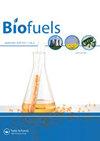Pre-treatment of waste cooking oil by combined activated carbon adsorption and acid esterification for biodiesel synthesis via two-stage transesterification
IF 2.6
4区 工程技术
Q3 ENERGY & FUELS
引用次数: 3
Abstract
Abstract The abundance of waste cooking oil (WCO) makes it an attractive alternative for biodiesel production. To date, research emphasizing biodiesel production via two-step transesterification from WCO, with the pre-treatment of WCO using combined activated carbon adsorption and acid esterification, is limited. Therefore, it is the aim of this study to (1) reduce the free fatty acid of WCO through a combination of pre-treatment using activated carbon and esterification of acid catalysis simultaneously, (2) maximize the production of biodiesel via a two-step transesterification process, and (3) compare the converted biodiesel against the biodiesel standards. The amount of activated carbon and the reaction time for each step of the transesterification process are varied. The combination pre-treatment method has successfully reduced the FFA content in WCO from 9.297% to below 3%. The produced biodiesel is verified as fully converted biodiesel via solubility testing in ethanol. The optimum conditions for biodiesel production are pre-treatment using 5 g of powdered activated carbon and a reaction time for each transesterification step of 30 min. The biodiesel generated under these conditions meets the biodiesel standards. It has the highest content of saturated fatty acid, with the maximum biodiesel yield of 52.78%.活性炭吸附-酸酯化联合预处理废弃食用油两段酯交换法合成生物柴油
摘要大量的废弃食用油使其成为生产生物柴油的一种有吸引力的替代品。到目前为止,强调从WCO通过两步酯交换生产生物柴油,并使用活性炭吸附和酸酯化相结合的WCO预处理的研究是有限的。因此,本研究的目的是:(1)通过活性炭预处理和酸催化酯化的结合,同时降低WCO的游离脂肪酸;(2)通过两步酯交换工艺最大限度地生产生物柴油;(3)将转化的生物柴油与生物柴油标准进行比较。酯交换过程的每个步骤的活性炭的量和反应时间是变化的。联合预处理方法成功地将WCO中的FFA含量从9.297%降低到3%以下。通过在乙醇中的溶解度测试,验证生产的生物柴油是完全转化的生物柴油。生产生物柴油的最佳条件是使用5进行预处理 g粉末状活性炭,每个酯交换步骤的反应时间为30 min在这些条件下产生的生物柴油符合生物柴油标准。它的饱和脂肪酸含量最高,生物柴油的最高产量为52.78%。
本文章由计算机程序翻译,如有差异,请以英文原文为准。
求助全文
约1分钟内获得全文
求助全文
来源期刊

Biofuels-Uk
Energy-Renewable Energy, Sustainability and the Environment
CiteScore
5.40
自引率
9.50%
发文量
56
期刊介绍:
Current energy systems need a vast transformation to meet the key demands of the 21st century: reduced environmental impact, economic viability and efficiency. An essential part of this energy revolution is bioenergy.
The movement towards widespread implementation of first generation biofuels is still in its infancy, requiring continued evaluation and improvement to be fully realised. Problems with current bioenergy strategies, for example competition over land use for food crops, do not yet have satisfactory solutions. The second generation of biofuels, based around cellulosic ethanol, are now in development and are opening up new possibilities for future energy generation. Recent advances in genetics have pioneered research into designer fuels and sources such as algae have been revealed as untapped bioenergy resources.
As global energy requirements change and grow, it is crucial that all aspects of the bioenergy production process are streamlined and improved, from the design of more efficient biorefineries to research into biohydrogen as an energy carrier. Current energy infrastructures need to be adapted and changed to fulfil the promises of biomass for power generation.
Biofuels provides a forum for all stakeholders in the bioenergy sector, featuring review articles, original research, commentaries, news, research and development spotlights, interviews with key opinion leaders and much more, with a view to establishing an international community of bioenergy communication.
As biofuel research continues at an unprecedented rate, the development of new feedstocks and improvements in bioenergy production processes provide the key to the transformation of biomass into a global energy resource. With the twin threats of climate change and depleted fossil fuel reserves looming, it is vitally important that research communities are mobilized to fully realize the potential of bioenergy.
 求助内容:
求助内容: 应助结果提醒方式:
应助结果提醒方式:


